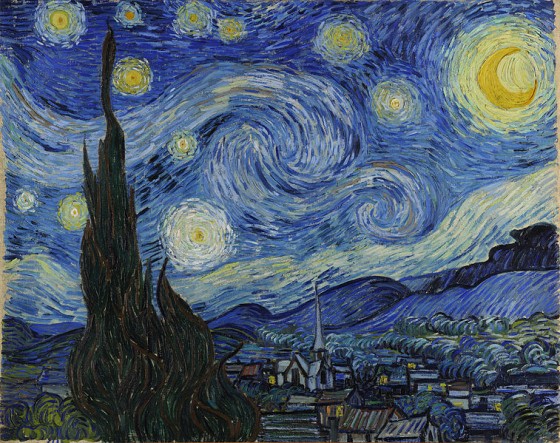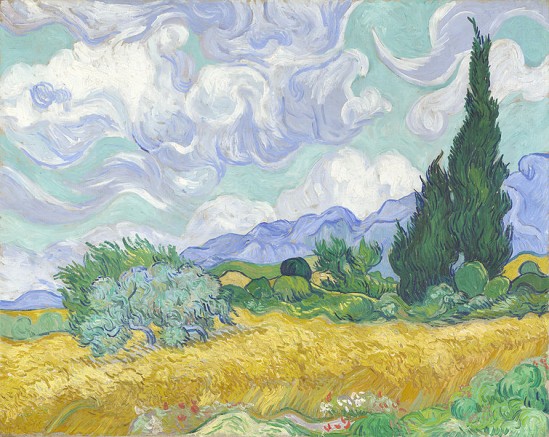Van Gogh's Road with Cypress and Star (aka Country Road in Provence by Night) from WikiCommons
I have a print of his one hanging in my living room and it has grown on me quite a bit over the last year. I like the juxtaposition between the dark foreboding sky and the light path with two farmers walking home from work. It feels like Fall to me with rich colors and the farmers in their heavy coats. There's a chill in the air.
Van Gogh painted this in May of 1890 while he was staying in a mental hospital in Saint-Rémy that had once beena monastery. He was institutionalized there after a series of breakdowns in early 1889, and it ended up being one of the most creative times of his life. The hospital was surrounded by beautiful open fields that inspired much of his work for the next year, when he worked on a series of paintings of cypresses including "A Wheatfield with Cypresses," "Road with Cypress and Star" (picture above), and probably his best known of these pieces, "Starry Night" (pictured below).
"Starry Night" with a cypress tree and swirling sky
Van Gogh Describes the Painting
In this letter to Paul Gaugin written June 17, 1890, Van Gogh described "Road with Cypress and Star":
I still have a cypress with a star from down there, a last attempt – a night sky with a moon without radiance, the slender crescent barely emerging from the opaque shadow cast by the earth – one star with an exaggerated brilliance, if you like, a soft brilliance of pink and green in the ultramarine sky, across which some clouds are hurrying. Below, a road bordered with tall yellow canes, behind these the blue Basses Alpes, an old inn with yellow lighted windows, and a very tall cypress, very straight, very sombre.
On the road, a yellow cart with a white horse in harness, and two late wayfarers. Very romantic, if you like, but also Provence, I think.
This painting is also known as "Country Road in Provence by Night."
Analysis of "Road with Cypress and Star"
In Eternity's Gate: The Spiritual Vision Of Vincent Van Gogh, Kathleen Powers Erickson surmises that the painting showed Van Gogh was realizing he was close to the end of his life:
Here, the idyllic image of the wayfarers, who wander on the road, with a horse-drawn carriage following behind, indicate Van Gogh's need for companionship and love. The travelers are like pilgrims on a journey, in the presence of the looming cypress, which divides the pictorial space, emphasizing it's vertical thrust. The image of the landscape indicate van Gogh's continued concerned with eternity and life after this world. On one side of the cypress is a radiant evening star, with concentric circles of light, seen as it barely emerges in the night sky. On the other side of the cypress, the obelisk of death, is the newly formed crescent moon, which recalls van Gogh’s prevailing concern with renewal and rebirth, the consolation of the end of the spiritual journey — a parallel to Bunyan’s life of the Celestial City, as it beckons the pilgrams to their eternal home. This painting, even more than “Starry Night”, reflects the somber reality that van Gogh has begun to believe that we was nearing the end of his earthly life and was looking to the hope of eternal release in death. Van Gogh’s “Starry Night” mediates between the two worlds of heaven and earth, life and death, the world “at eternity’s gate.” The passing of the day into night, the imposing image of the cypress as it soars from the earth to the heavens, and the stars, which represent van Gogh’s longing for ultimate union with the Infinite Being, evoke thoughts of death and immortality.
In The Pursuit of Spiritual Wisdom: The Thought and Art of Vincent Van Gogh and Paul Gauguin, Naomi Margolis Maurer also sees Van Gogh feeling his own death coming:
Like the painting “Starry Night,” this “last attempt” from Provence depicts the human life in the context of infinity and eternity. The wayfarers on their winding road, the patient horse plodding between the traces, the little inn providing sustenance and cheer for the traveler — all are dominated by the awesome cypress that cleaves the center of the composition. On either side of the this symbol of grief and death, the evening star and the new moon fill the darkening sky with expanding circles of radiant energy. Suggesting a sentient universe filled with love and the eternal possibility of the rebirth and renewal. They add a cosmic perspective to the earthly scene which gives us spiritual consolation on our journey. It seems significant that both of van Gogh’s last pictures from Provence depict the twilight, for it was the end of this year in St. Remy that he began to feel he had reached the evening of his life.
Look!: Seeing the Light in Art by By Gillian Wolfe looks at the lighting in the painting:
…the people hardly matter because all the drama is in the sky.
This is no ordinary summery night. A brilliant halo of light surrounds the golden star, making it appear to spin and vibrate. We often think of the moon as pale and silvery, but van Gogh’s moon almost burns with crusty textured yello and orange. His excited brushstrokes give a wild feel to the luminous sky. It looks as if he painted fast and furiously. His thick strokes of glowing colour gives the surface a rich and craggy feel.
Van Gogh's Stormy Patterns Are A Great Representation of Real Life Turbulence
As for many folks, the whirling patterns in this painting stick in my mind the more I look at it. According to a recent study, they are a very strong representation of real life turbulence:
Now a mathematical analysis of his works reveals that the stormy patterns in many of his paintings are uncannily like real turbulence, as seen in swirling water or the air from a jet engine.
Physicist Jose Luis Aragon of the National Autonomous University of Mexico in Queretaro and his co-workers have found that the Dutch artist's works have a pattern of light and dark that closely follows the deep mathematical structure of turbulent.
The swirling skies of "The Starry Night," painted in 1889, "Road with Cypress and Star" (1890) and "Wheat Field with Crows" (1890) — one of the van Gogh's last pictures before he shot himself at the age of 37 — all contain the characteristic statistical imprint of turbulence, say the researchers.
Wongturn's Blog has more analysis on the chaos and the colors of Van Gogh's work.
Another Cypress Work I Really Like
"A Wheatfield with Cypresses" is my favorite Van Gogh at the moment. I wrote a lot more about it here.
A Collection of Some of Van Gogh's Work
This is a great set to browse through to see some of his best work:



Follow Us On